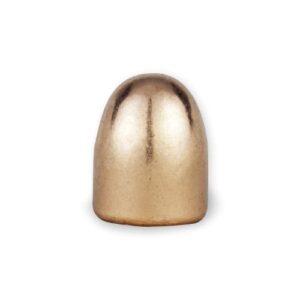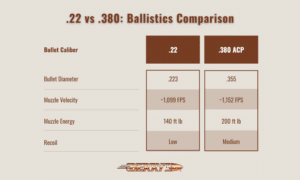Your cart is currently empty!

.22 vs .380: Caliber Comparison
Table of Contents:
- The History of the Two Calibers: 22 and 380
- .22 vs .380: Ballistics
- Practical Use Cases: Which Caliber is Better for Self-Defense?
- How Berry’s Bullets Can Help
One of the more popular debates among shooting enthusiasts in the forum community these days is which is better: the .22 or .380 caliber? For some seasoned shooters, the smaller .22 rimfire ammo might seem underwhelming for protection. On the other hand, there’s the heavier .380. Although often considered an ideal pocket pistol and personal protection round, some might argue that its recoil presents a challenge for accurate shooting. So which is the better caliber for you?
The Short Answer: Both calibers have their merits. The .22 is lightweight, affordable, and has less recoil than the .380. This caliber is primarily used for plinking and small game hunting but has become more popular as a self-defense round as well. The .380, being a centerfire cartridge, holds more power and is a more common choice for self-defense uses.
The History of the Two Calibers: 22 and 380
Understanding the full story of the .22 and .380 calibers requires starting from the beginning, tracing back their origins and development to where they stand in today’s market.
History of the .22 Caliber
One of the most seasoned members of the bullet family, the .22 caliber owes its legacy to Smith & Wesson (S&W). Created in 1857, the .22 began as a practical and economical option for target practice. However, as time passed, its uses blossomed to encompass small-game hunting as well.
Known and loved for its light recoil, the .22 has always been an easy caliber to handle, endearing itself to a broad user base. Whether used in a long rifle or a short barrel pistol, the .22 rimfire cartridge remains a household name and a common caliber in the recreational shooting scene.
History of the .380 Caliber
When you hear .380 caliber, the first thing that likely comes to mind is defensive pistols. Also known as the 9mm Short or Automatic Colt Pistol (ACP), the .380 ACP is a centerfire cartridge with a rich history. Developed in 1908 by Colt Manufacturing Company, the .380 ACP earned its fame when it caught the attention of law enforcement agencies and military branches worldwide.

.22 vs .380: Firearm Fit
Over the years, the caliber has found itself as the round of choice in several notable firearms. From the compact Walther PP and Bersa Thunder to the subcompact Ruger LCP, the .380 ACP has showcased its tenacity and versatility despite its compact size. On the other hand, the .22 caliber fits a variety of firearms ranging from precision rifles for target shooting to small-frame revolvers for close range encounters.
Whether you’re considering a switch in calibers or are new to the world of shooting, understanding their rich histories and firearm fitment brings you a step closer to making an informed purchase decision.
.22 vs .380: Ballistics
To fully understand the performance capabilities of both the .22 and .380 caliber, we’ll need to dive into ballistics, starting with bullet diameter, muzzle energy, and velocity.

.22 Caliber Ballistics
The .22 caliber is the smaller caliber, usually coming with a bullet diameter of .223 inches. When fired from a firearm with a 6-inch barrel length, the .22 typically has a muzzle velocity of about 1,099 feet per second, and the muzzle energy that it produces is around 140 ft lb. This results in a relatively less felt recoil, which is a significant plus point for new or recoil-sensitive shooters. The .22 can offer solid penetration, but ballistic gel tests on the .22 have determined that the caliber is largely inconsistent in this respect.
.380 Caliber Ballistics
The bullet diameter of a .380 ACP measures .355 inches. The standard .380 ACP round fires with a muzzle velocity of around 1,152 feet per second from a 6″ barrel. This typically results in a muzzle energy of about 200 ft lb, giving more stopping power than the .22. The recoil, though more than the .22, is manageable for most shooters and may be preferred by some for its greater feedback. In terms of ballistic gel tests, the .380 ACP penetrates anywhere from 6.5 to 17 inches, adequate for reaching a vital organ with a well-placed shot.
Comparing the two, the .380 carries more energy and delivers more on-target impact, making it a better choice if stopping power is the primary consideration. If manageable recoil and shot placement are your biggest concerns, the .22 is your best bet.
Practical Use Cases: Which Caliber is Better for Self-Defense?
The real-world capability of a caliber primarily hinges on your needs and situation. Let’s take a look at how the .22 and .380 fare when it comes to personal protection.
.22 Caliber for Self-Defense
The .22 caliber is renowned for its excellence in recreational shooting, most commonly in competition target shooting and casual plinking. This caliber shines due to its minimal recoil and affordability. Its lighter recoil not only makes it an ideal choice for new shooters but also allows for longer shooting sessions where the user prioritizes minimal fatigue. Although not primarily designed or promoted for self-defense, many people still turn to the .22 due to its lightweight frame and less felt recoil than larger calibers.
.380 Caliber for Self-Defense
On the other hand, the .380 caliber is better suited for self-defense, especially in scenarios that require a compact and concealable firearm. The .380 ACP is powerful enough to be effective in close-quarters self-defense situations. Utilizing hollow point .380 bullets can help prevent over-penetration, a crucial consideration in defensive settings to maximize impact and minimize risk to bystanders. The compact nature of most .380 pistols combined with their relatively manageable recoil makes them an excellent choice for a personal defense weapon that can be carried discreetly and deployed quickly.
The takeaway here? The effectiveness of the .22 or .380 all comes down to the user – their comfort, accuracy, and intended use.
How Berry’s Bullets Can Help
After comparing the .22 and .380 calibers head-to-head, it’s clear that both have their strengths and applications, particularly in recreational shooting and self-defense. However, for those leaning toward the .380, the next question is: where can you source the best bullets? For over 60 years, Berry’s Bullets has been making superior bullets in bulk designed to offer a consistent, reliable performance shot after shot. Our superior-plated .380 bullets are created using the finest materials at an affordable price, offering an exceptional shooting experience.
Ready to step up your shooting game? Explore our range of .380 bullets and discover the Berry’s Bullets difference today!
